今回の「英語で東京を案内してみよう」シリーズは「明治神宮」をピックアップしていきます!
今回は明治神宮の概要、南参道、明治神宮の杜などを説明した前編に続き、後編をお送りいたします。
前編をお読みでない方は、まずは前編を読んでから、お進みください!

【ガイドライター】
齋藤 一美(さいとう かずみ)
—————–
2016年に英語全国通訳案内士資格取得。通訳ガイド派遣会社でのコーディネーター職を経てフリーランスの通訳ガイドに。コロナ禍の現在は前職の介護福祉士として高齢者ケアの仕事に従事中。グーグルマップを見ながら妄想旅のプランをあれこれ練ってるときが至福の時間。
明治神宮の案内にチャレンジしてみよう!
手水舎にて
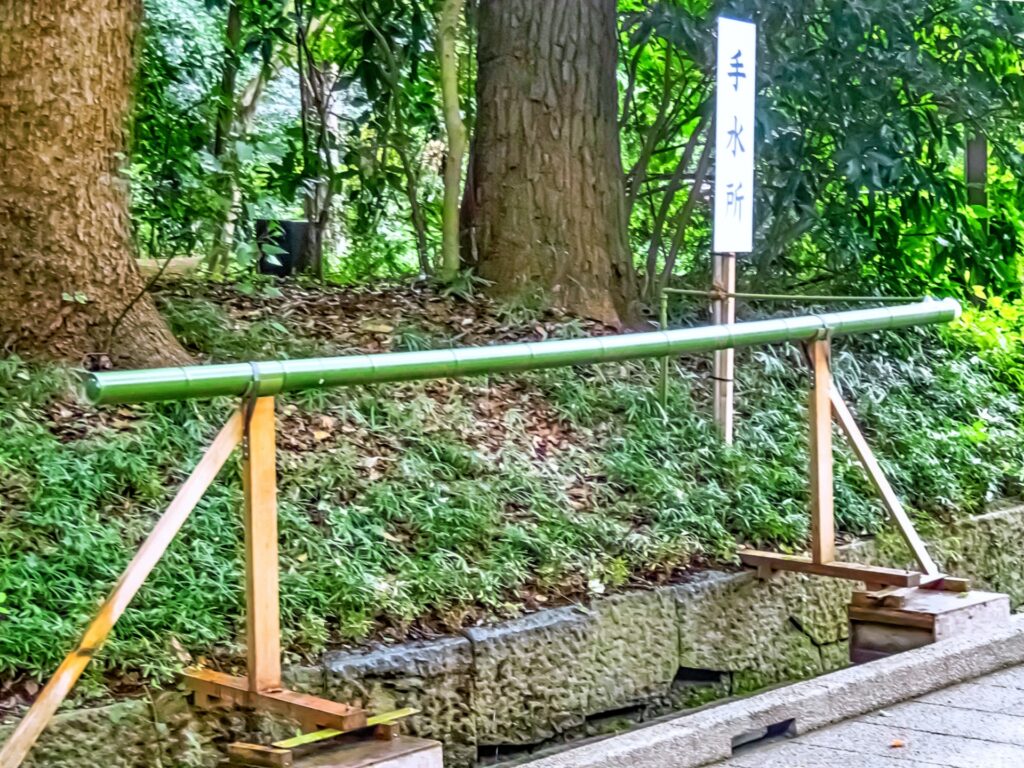
▶こちらは「手水舎」です。「手水舎」とは、神様へ参拝する前に浄化する場所です。

This is a “Temizuya/Chozuya”. “Temizuya” is a place to purify before praying to deities.
▶本来、手水舎には柄杓があるのですが、新型コロナウィルス感染症の対策として、多くの神社やお寺で柄杓が撤去されました。

Originally, there was a hishaku, a ladle, in the Temizuya, but as a countermeasure against COVID 19, currently hishaku was removed at many shrines and temples.
▶明治神宮では、このようにスタイルを改良し、竹を利用した数か所の口から水を少しずつ流しています。

At Meiji Jingu, the style was improved like this so that water is flushing little by little from several bamboo faucets.
▶柄杓がないのでちょっと変わりますが、浄化の作法としては、まず左手を洗い、次に右手を洗い、左の手のひらに水を溜め、その水で口をすすぎます。口をすすいだら、もう一度水を左手にかけます。

It’s a little different because there is no hishaku, but the method of purification is to wash your left hand first, then wash your right hand, collect water in the palm of your left hand, and rinse your mouth with that water. After rinsing your mouth, wash your left hand again.
▶口をすすぐことに抵抗があったら無理しなくても大丈夫です。

If you are reluctant to rinse your mouth here, you don’t have to do it.
南神門にて
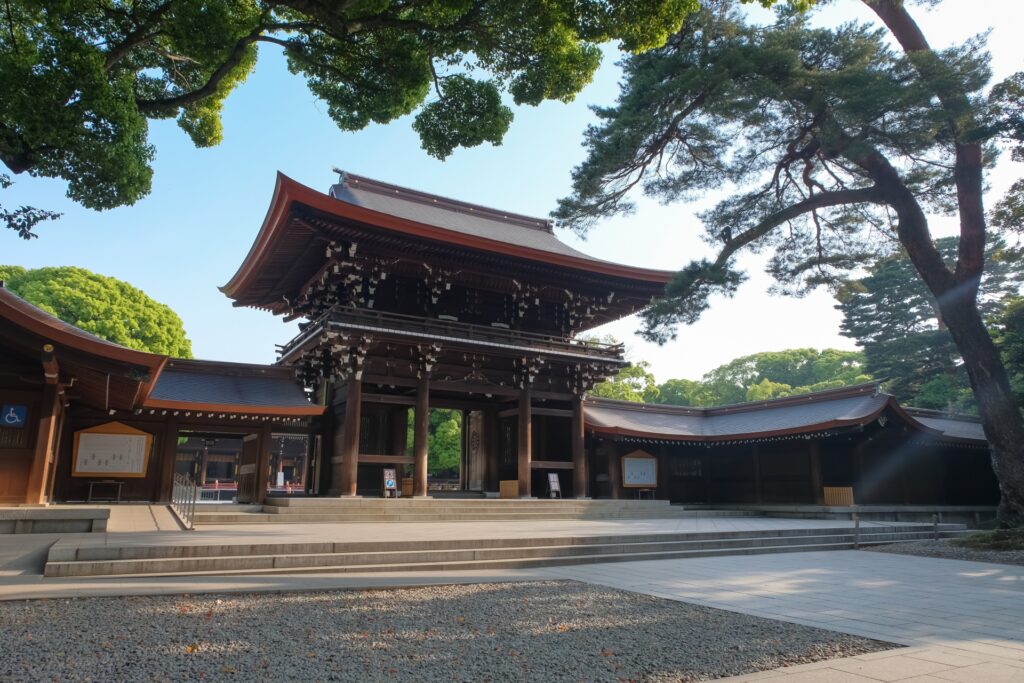
▶この門は社殿の南側に位置する門で「南神門」といいます。

This gate is located on the south side of the shrine and is called “Minami Shinmon or Main Gate”.
▶創建当時の本殿や拝殿を含む中心部の社殿は1945年に空襲により焼失しましたが、この門と、左右の門「東神門」と「西神門」や周辺の建物は創建当時のものです。

The original shrine buildings at the center, including the main shrine and worship hall, were burnt down by air raids in 1945. But this gate and the gates on both sides “Higashi Shinmon” and “Nishi Shinmon” and the surrounding buildings are the original buildings that survived.
▶焼失した社殿は1958年に再建されました。

The burnt-down shrine buildings were reconstructed in 1958.
▶そして再建時には、社殿の立ち並ぶ構成が変更され、また屋根も檜皮葺から銅板葺へ変更されました。

And, at the time of reconstruction, the structure of the shrines lined up was changed and the roof was also changed from a thatched roof to a copper plate roof.
▶また、明治神宮鎮座百年記念事業の一環として2016年から2019年まで4年間、大規模な社殿の改修工事が行われています。

Moreover, a large-scale renovation of the shrine buildings was carried out for four years from 2016 to 2019 as part of the Meiji Jingu Shrine 100th Anniversary Project.
▶2020年12月に、本殿、内拝殿、外拝殿、各神門などを含む、社殿36棟が国の重要文化財に指定されました。

In December 2020, 36 shrine buildings, including the main shrine, inner worship hall, outer worship hall, and each shinmon or gate, were designated as national important cultural properties.
夫婦楠について
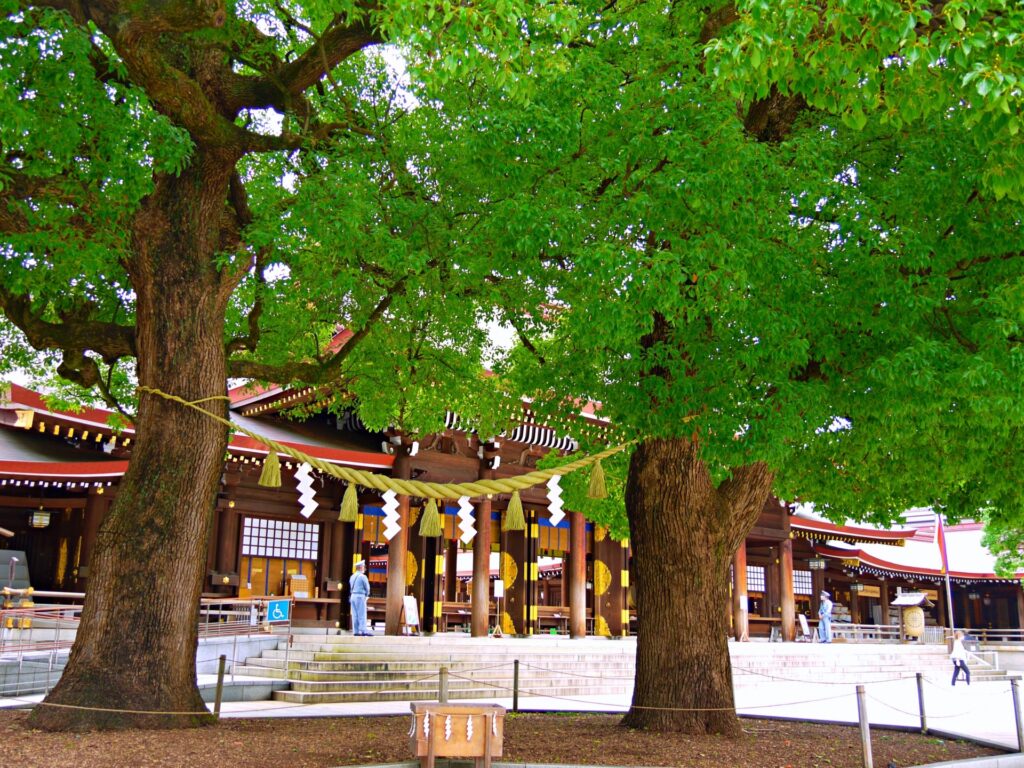
▶拝殿の手前の左手にある大きな木は楠です。1920年の明治神宮創建時に苗木から植えられました。2本の木が寄り添っているように見えること、また御祭神の明治天皇ご夫妻が仲睦まじかったことから「夫婦楠」と呼ばれています。

The large trees on the left in front of the worship hall are camphor trees. They were planted with saplings when Meiji Jingu was established in 1920. They are called “Meoto Kusu or Camphor Tree Couple” because the two trees look leaning against each other like a couple that was reminiscent of Emperor Meiji and his wife.
▶恋愛成就や夫婦円満のパワースポットとして知られています。

It is believed to grant a wish for romance and happy marriage.
▶木と木の間にあるロープは「注連縄」と言い、ぶら下がっているギザギザの白い紙は「紙垂」と言います。

The rope between the trees is called “Shimenawa”, and the hanging jagged white paper is called “Shide”.
▶これらは神社などでよく見られるもので、神聖な場所であることを表しています。また、神域と現世を隔てる結界の役割や、悪霊を祓う意味もあります。

These are often seen in shrines and represent a sacred place. It also has the role of a barrier that separates the sanctuary from this world and also has the meaning of warding off evil spirits.
外拝殿にて
▶こちらの建物は外拝殿です。その奥に内拝殿があり、本殿は更にその奥にあります。

This building is the outer worship hall. There is the inner worship hall in the back, and the main shrine is further in the back.
▶一般の参拝客は内拝殿や本殿へ入ることが出来ません。

General visitors cannot enter the inner worship hall or the main shrine.
▶本殿には、明治神宮の御祭神である明治天皇と皇后の「御霊」が祀られています。

The main shrine enshrines the “spirit” of Emperor Meiji and the Empress, the deities of the Meiji Shrine.
▶実際のお墓は、明治天皇の遺志により京都にあります。

Their actual tomb is in Kyoto at the will of Emperor Meiji.
▶ところで神道では、神様は一つの場所にとどまっているのではなく、あらゆる所に宿ると信じられており、お祀りするたびにその場に降臨されると考えられています。

By the way, in the Shinto religion, it is believed that Kami or the deities do not stay in one place, but dwell in every place, and it is believed that they will descend to that place every time of worship.
▶️そして神社には、神様の御霊を降臨させる「御神体」と呼ばれるものが人目に触れないよう厳重に保管され本殿の奥に安置されています。

And, at shrines, the object called “Goshintai,” for descending the spirit of Kami, is carefully stored and enshrined in the inner part of the main shrine so that it is not visible to the public.
▶それでは参拝をしましょう。神社での参拝方法をご説明しますね。

Then it’s time to pray! I will explain how to pray at the shrine.
▶先ずは賽銭箱へお金をそっと入れます。金額の決まりはありません。感謝の気持ちを込めることが一番大切です。

First, gently put the money in the offertory box. There is no fixed amount. It is most important to express gratitude.
▶そして、2回深くお辞儀をしてから、柏手を2回打ち、手を合わせて心を込めてお祈りをします。最後にもう一度深いお辞儀をします。

Then, bow twice deeply, clap your hands twice, and pray with all your heart. Finally, bowing deeply again one more time.
▶柏手を打つことは、音を立てることによって「お参りに来ました!」と神様を呼び出す意味があるんです。

Clapping hands has the meaning of calling Kami by making a noise, saying “I came to visit you!”.
絵馬について
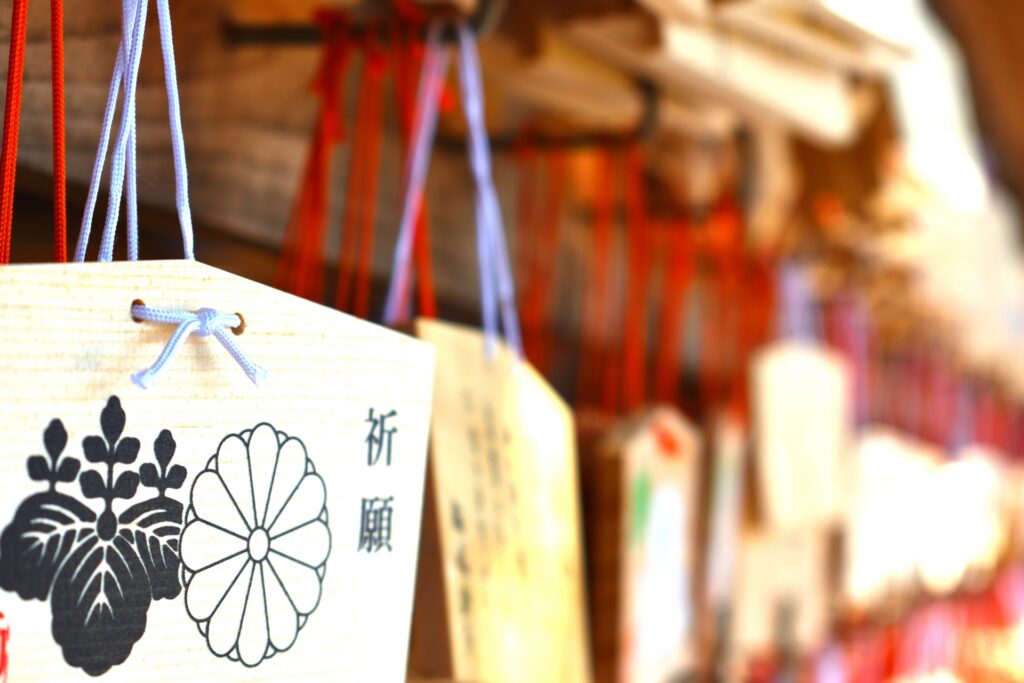
▶木の周りのラックにぶら下がっているたくさんの小さな木の板は「絵馬」といい、願い事や願いが叶った感謝の意を書き、神社へ奉納するものです。

Many small wooden plates hanging on the rack around the tree are called “Ema or votive tablets”, and they are dedicated to the shrine by writing a wish or gratitude for the fulfillment of the wish.
▶「絵馬」の「E」は「絵」、「ma」は「馬」という意味です。

The “E” in “Ema” means “picture” and “ma” means “horse”.
▶なぜ「絵馬」というかというと、古来より神様は馬に乗って人間の住む俗世界に降りてくるといわれており、昔は生きている馬を神社へ奉納していたそうです。

Since ancient times it has been believed Kami rides on horses and descends into the world where humans live, and in the old days, living horses were dedicated to shrines.
▶その後、木、紙、土などで作った馬で代用するようになり、やがて馬の絵を描いた「絵馬」が主流になっていきました。

After a while, horses made of wood, paper, soil, etc. were used as substitutes, and eventually, “Ema” depicting a horse became the mainstream.
▶今では「絵馬」に描かれている絵は馬だけでなく、神社によってユニークな絵や形の「絵馬」が色々あります。

Nowadays, the pictures drawn on “Ema” are not limited to horses, but there are various unique pictures and shapes of “Ema” depending on shrines.
お守りと大御心について
▶こちらの建物では、「お守り」や「おみくじ」などが売られています。

“Omamori” and “Omikuji” are sold in this building.
▶「お守り」とは、厄除けや招福のための縁起物で、常に携帯することで悪霊から身を防ぎ、ご利益を得ることができると信じられています。

“Omamori” is a lucky charm for warding off evil and receiving blessings, and it is believed that you can protect yourself from evil spirits and get benefit from it by always carrying it with you.
▶「お守り」の中には、紙や木、金属でできた「御神璽(ごしんじ)」という神の宿るおふだが入っています。

Inside the “Omamori”, contains an amulet made of paper, wood, or metal called “Goshinji”, where the deities dwell.
▶「お守り」はたいていの神社やお寺で購入でき、健康やお金、開運、良縁、商売など、あらゆる種類のお守りがあります。

“Omamori” can be purchased at most shrines and temples, and there are many kinds of “Omamori” such as for good health, money, good luck, good matches, business, and so on.
▶明治神宮でも、たくさんの種類のお守りが売られていますが、明治神宮でしか売られていないユニークで人気のお守りのひとつは「開運木鈴こだま」です。このお守りは、明治神宮の杜の中の自然に折れた「御神木」から作られています。

Many types of Omamori are also sold at Meiji Jingu, but one of the unique and popular Omamori which is sold only here is “Kaiun Mokurin Kodama”, a wooden bell for good luck. This is made from the naturally broken “Goshinboku or the sacred trees” in the forest of Meiji Jingu.
▶そして、明治神宮の「おみくじ」はとても特別です。通常の「おみくじ」は運勢が書かれた紙ですが、明治神宮のおみくじは「大御心」と呼ばれ、明治天皇と皇太后が作られた「和歌」が書かれています。

And the “Omikuji” of Meiji Jingu is very special. The usual “Omikuji” is a paper on which fortune is written, but the Omikuji of Meiji Jingu is called “Omikokoro”, and “Waka” made by Emperor Meiji and the Empress is written.
▶「和歌」とは1000年以上前に日本で生まれた詩の型で「五・七・五・七・七」の31音節で、情景や恋心などを表現したものが多く、昔は主に皇族や貴族によって詠まれていました。

“Waka” is a type of poetry that was born in Japan more than 1000 years ago. It has 31 syllables of “5,7,5,7,7”, and many of them express scenes and love, and anciently it was mainly written by the imperial family and aristocrats.
▶明治天皇ご夫妻は和歌を詠むことを好まれ、またとてもお上手でした。

Emperor Meiji and the Empress liked to write “Waka” and were very good at it.
▶「大御心」には、明治天皇と皇太后が作られた数多くの和歌の中から、特に人倫道徳の指針となる教訓的なものが30首選出されています。また、英訳も書かれています。

For “Omikokoro”, from many of “Waka” written by Emperor Meiji and the Empress, 30 pieces have been selected which are the guideline for humanity and morality. It is also written in English translation.
車祓舎について
▶こちらの場所は、海外の人たちにしたら特にユニークかもしれません。車両の浄化の儀式に使われる場所なんです。

This place may be particularly unique. It is used for vehicle purification rituals.
▶車などを持ち込むと、神社の神官が禍を祓う儀式を行い、事故のない安全運転を祈願してくれます。 人々は通常、新しい車を購入するときにこれを行います。

If you bring a car or any vehicle here, a shrine priest will perform a ritual to ward off bad luck and pray for safe driving without accidents. People usually do this when buying a new car.
帰路にて
▶明治神宮は如何でしたか?神社を楽しんで、杜の癒しのパワーを感じて頂けてたら嬉しいです。

How was Meiji Jingu? I hope you enjoyed the shrine and felt the healing power of the forest.
▶ところで、同じ道を戻ってもいいですが、よかったら、別の参道を通って帰りませんか?社殿の裏手には芝生のエリアもあり、人もほとんどいなく静かで、都会の真ん中にいることを完全に忘れてしまうような景色が広がっていますよ!

By the way, you can go back the same way, but if you like, why don’t you go back through another approach? There is also a lawn area behind the shrine, which is very quiet with few people, and the scenery that makes you completely forget that you are in the middle of the city!
▶北参道から出ると、副都心線の「北参道駅」か、JR線と大江戸線の「代々木駅」まで、どちらも5分ほどです。

From Kitasando, it takes about 5 minutes to reach “Kitasando Station” on the Fukutoshin Line or “Yoyogi Station” on the JR and Oedo Lines.
▶西参道から出ると、小田急線の「参宮橋駅」まで3分ほどです。

From Nishisando, it takes about 3 minutes to reach “Sangubashi Station” on the Odakyu Line.
明治神宮データ&ワード集
明治神宮に関するデータやワードをいくつかまとめてみました。ガイディング前のインプットにぜひご活用ください!
創建 / Establishment
▶1920年11月1日 / November 1, 1920
御祭神 / Enshrined Kami, deities
▶明治天皇と昭憲皇后 / Emperor Meiji and Empress Shoken
境内面積 /Precinct area
▶約70万㎡ / 70ヘクタール/約175エーカー/ About 700,000 square meters or 70 hectares / About 175 acres
創建前の土地 / Land before the establishment
▶江戸時代初期 — 熊本藩/肥後藩 藩主・加藤家の別邸/ Early Edo period — The villa of the Kato family, the feudal lord of the Kumamoto/Higo domain
▶1640年以降 — 彦根藩 藩主・井伊家の下屋敷/ After 1640 — The suburban residence of the Ii family, the feudal lord of the Hikone domain
▶1874年以降 — 皇室の御料地 / After 1874 — The Imperial Property
3つの参道 / Three approaches
▶南参道(原宿駅)/Minami Sando, Southern approach (Harajuku Station)
▶北参道(北参道駅、代々木駅)/Kita Sando, Northern approach (Kitasando Station, Yoyogi Station)
▶西参道(参宮橋駅)/ Nishi Sando, Western approach (Sangubashi Station)
酒樽の数 / Number of Sake Barrels
▶216
ワイン樽の数 / Number of Wine Barrels
▶60
鳥居の数 / Number of Torii gate
▶8
大鳥居のサイズ / Size of Ootorii, Great or Second Torii Gate
▶高さ12メートル、幅17.1メートル、 柱の直径1.2メートル、重さ13トン/ Height 12 meters, width 17.1 meters, pillar diameter 1.2 meters, weight 13 tons
社殿の主な建造物 / Main buildings of the shrine
▶本殿 / 内拝殿/ 内院渡廊 / 外拝殿 / 外院廻廊 / 玉垣/ Main Shrine / Inner Worship Hall / Inner Hall Connecting Corridor / Outer Worship Hall / Outer Hall Corridor / Fence around the Shrine
▶南神門 / 東神門 / 西神門/ Minami Shinmon, Main Gate / Higashi Shinmon, East Gate/ Nishi Shinmon, West Gate
※明治神宮HPの英語ページで「南神門」は”Main Gate”になっています。
▶神楽殿 / 手水舎 / 車祓舎 / Kaguraden, Hall of Shinto music and dance / Temizuya, Ritual Purification Building, Purification Trough / Vehicle Purification Building
鎮守の杜の樹木数 / Number of trees in the sacred forest
▶造営時 — 365種、約10万本/ At the time of construction — 365 species, about 100,000
▶2019年時点 — 234種、約3万6千本(残った木が巨木化/ As of 2019 — 234 species, about 36,000 (remaining trees become giant trees)
御苑に咲く花と見頃 / Flowers in the Garden and the best time to see
▶カタクリ(3月中旬〜4月初旬/ Dogtooth violet (Mid March to early April)
▶ヤマブキ(3月下旬〜4月中旬)/ Japanese rose, Kerria (Late March to mid-April)
▶フジの花(4月)/ Wisteria (April)
▶山ツツジ(4月〜5月/ Azalea (April to May)
▶花菖蒲(5月下旬〜6月下旬)/ Iris (Late May to Late June)
▶スイレン(6月〜9月)/ Water lily (June to September)
以上「英語で東京を案内してみよう」シリーズの「明治神宮」編は如何でしたでしょうか?
前編後編あわせると、本当にかなりのボリュームになってしまい(汗)ちょっと外国人の友達を案内してみたい、くらいの人にとっては頭の痛くなるような長さだったかもしれません。
が、先にも書いたように、言ってみたい内容だけピックアップして、気軽に楽しく英語で案内にチャレンジしてみてください!
英語を活かして外国人ゲストをおもてなし!
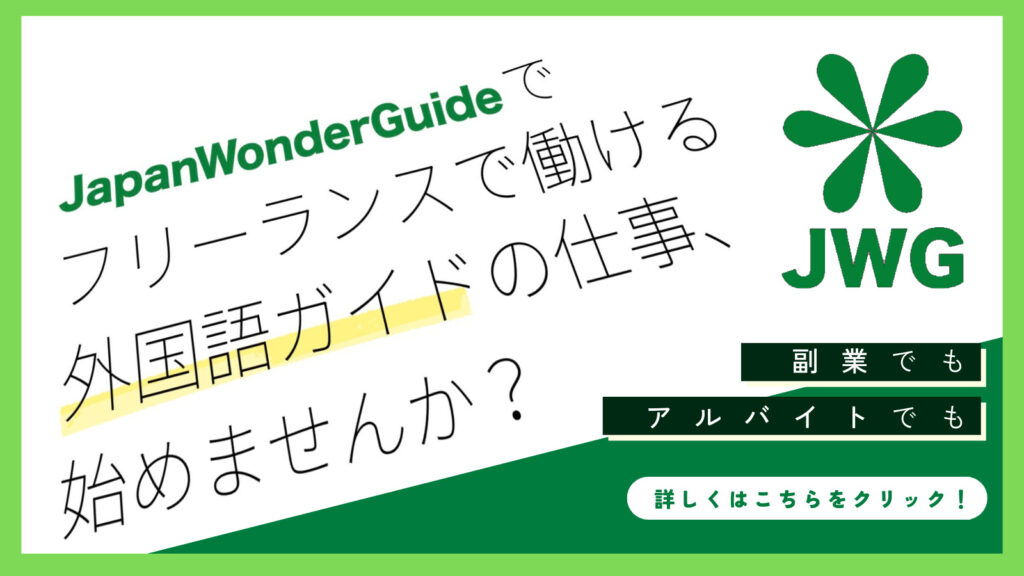
- 日本の魅力を外国人に紹介したい
- 英語や語学を活かした仕事がしたい
- 人を喜ばせることが好き
そんな方にぴったりな仕事が通訳案内士やツアーガイドのお仕事です。
通訳案内士(ツアーガイド)は、一緒に街を歩いて、地域の歴史や文化をお話しながら、外国人ゲスト一人一人の旅が素敵なものになるようお手伝いします。
ガイドの印象によって、日本の印象が決まると言っても過言ではありません。
人を楽しませることが好きで、日本の魅力を世界に伝えたい!という情熱をお持ちの方は、ツアーガイドを目指しませんか?

JapanWonderGuide(JWG)は「日本のガイドの質を世界一に」をスローガンに掲げるガイドコミュニティです。2020年から活動を開始し、全国通訳案内士等を中心に、現在は、2,000名を超えるコミュニティとなっております。
JWGの有料会員(KNOTTER, ノッター)にご登録いただくと、月額1,000円(税込1,100円)で、ガイディングやビジネスに活きる知識・スキルが身につく研修動画、E-Learningが見放題!有料コンテンツを無料でご視聴いただけます。
そのほか、下見やツアー時の観光施設の優遇利用や、人気観光施設の最新情報や裏話をお届けするJWG Live!の見逃し配信、各研修の割引などをご利用いただけます。
さらに、有料、無料会員様ともに研修やイベント情報など、ガイドに役立つ内容がたっぷり詰まったメルマガを月に2回お届けします。
また、ガイド仲間を見つけ、交流できるFacebookグループにもご招待!情報交換の場としてお使いください。
| フリーメンバー | KNOTTER | KNOTTER+ | |
| 料金 | 無料 | 月額1,000円 (税込1,100円) | 年間14,000円※ (税込15,400円) |
| 期間 | 無期限 | 毎月自動更新 | 2023年8月31日まで |
| ①Japan Wonder Travel プラットフォーム利用 | ○ | ○ | ○ |
| ➁メンバー限定Facebookグループご招待 | ○ | ○ | ○ |
| ③メンバー向けメルマガ受信 | ○ | ○ | ○ |
| ④JWG Live!見逃し配信 | △ | ○ | ○ |
| ⑤優待施設利用 | – | ○ | ○ |
| ⑥JWG主催研修割引 | – | ○ | ○ |
| ⑦通訳案内研修 | – (3,500円) | 無料 | 無料 |
| ⑧JWG動画配信 | 有料 | 無料 | 無料 |
| ⑨通訳ガイド保険 | – | – | ○ |
※KNOTTER+の会費は加入月によって変動します
JWGでは、ガイドのスキルアップを目指す方や、ガイドに挑戦したい新人ガイドさんを応援します!
「学校の合間に」「週末だけ」
JapanWonderGuideと一緒に、ツアーガイドへの一歩を踏み出しませんか?

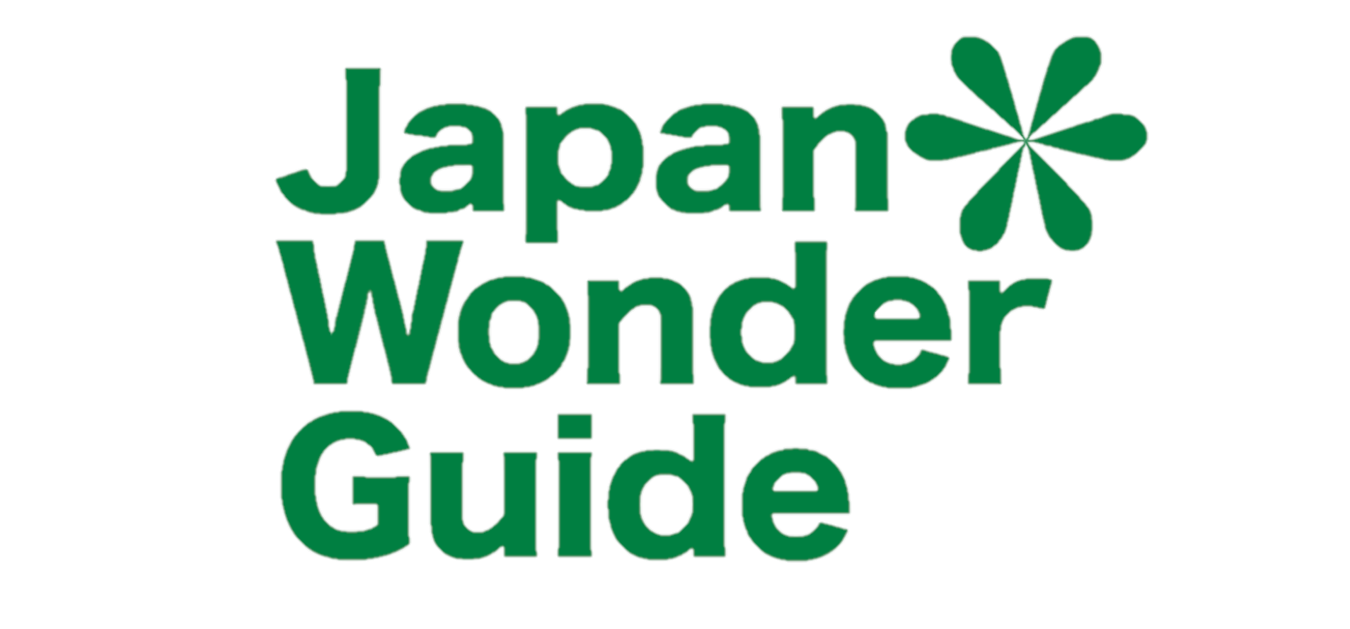







コメント